Learning and development are among the biggest growth opportunities for small and mid-sized businesses (SMBs).
The reasons why are clear—L&D is a powerful driver of performance, retention, and long-term growth. The facts prove it: companies offering comprehensive training programs experience a 218 percent higher income per team member and a 24 percent higher profit margin.
However, with limited time, budgets, and internal resources, deciding how to deliver training can feel like a guessing game.
Do you build internally? Buy externally? Make a blend of the two?
The truth is that what’s right for one business—or even one team—might be totally wrong for another.
That’s why we’ve created this workbook. This can act as your roadmap to cut through the noise of L&D and help you make confident, context-driven choices about the future of your training.
This workbook helps you:
- Make confident decisions about how to deliver training
- Align L&D investments with business outcomes
- Avoid costly tradeoffs and blind spots
You’ll learn how to:
- Compare the tradeoffs of building vs. buying training
- Analyze the type of knowledge you need to transfer
- Answer 10 key decision questions to assess feasibility
- Apply a structured framework to make your choice
- Define and measure training impact to show ROI
- Evaluate the long-term fit of your training strategy
For SMBs navigating fast growth, evolving skills gaps, or workforce development challenges, this is your hands-on guide to smarter, more strategic employee development.
Step 1: Compare the tradeoffs of building vs. buying
Every training strategy has its pros and cons.
But your best choice depends on your goals, constraints, and internal capabilities.
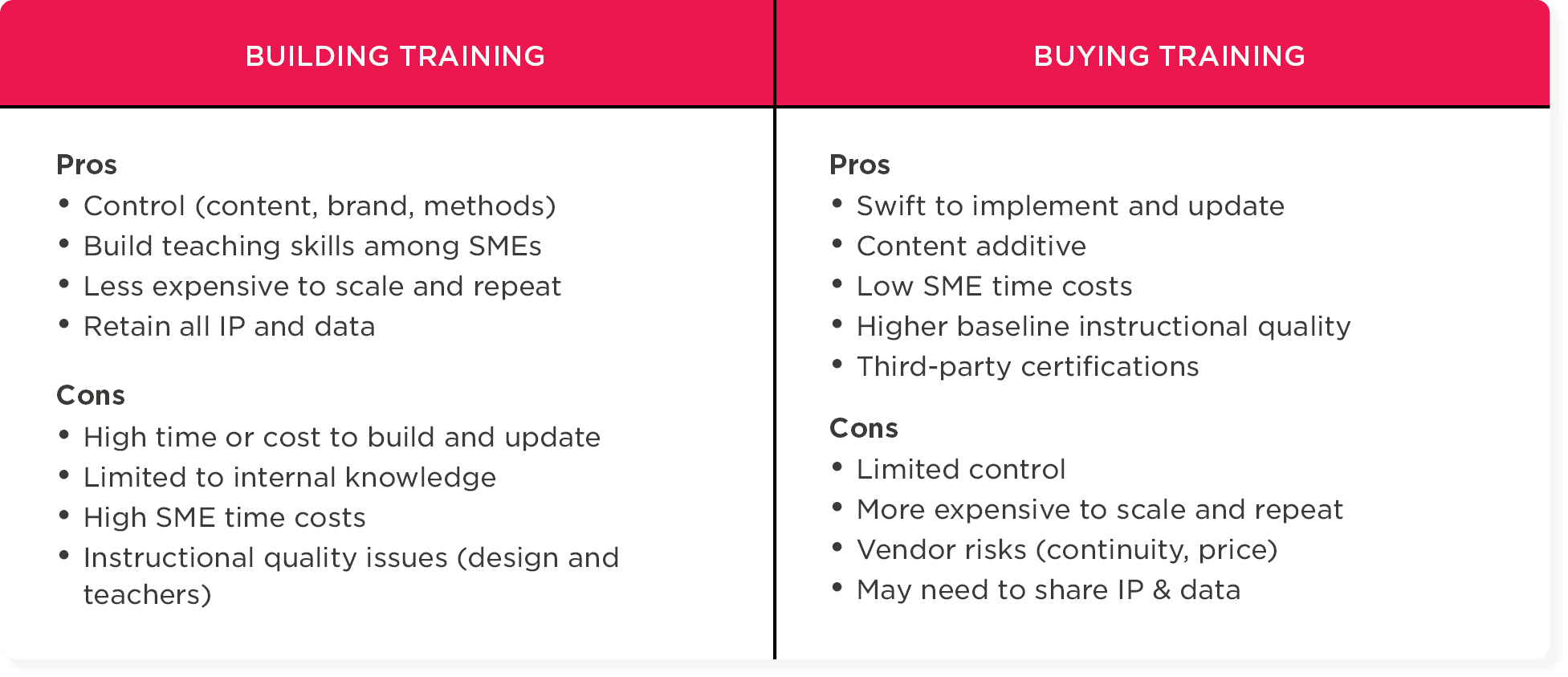
Understanding these tradeoffs is the very first step on your journey to align learning strategies with real-world business and talent development needs.
How to identify your delivery methods
This exercise helps you identify which delivery method best fits your team’s goals, internal bandwidth, and long-term L&D strategy.
Build vs. buy comparison table
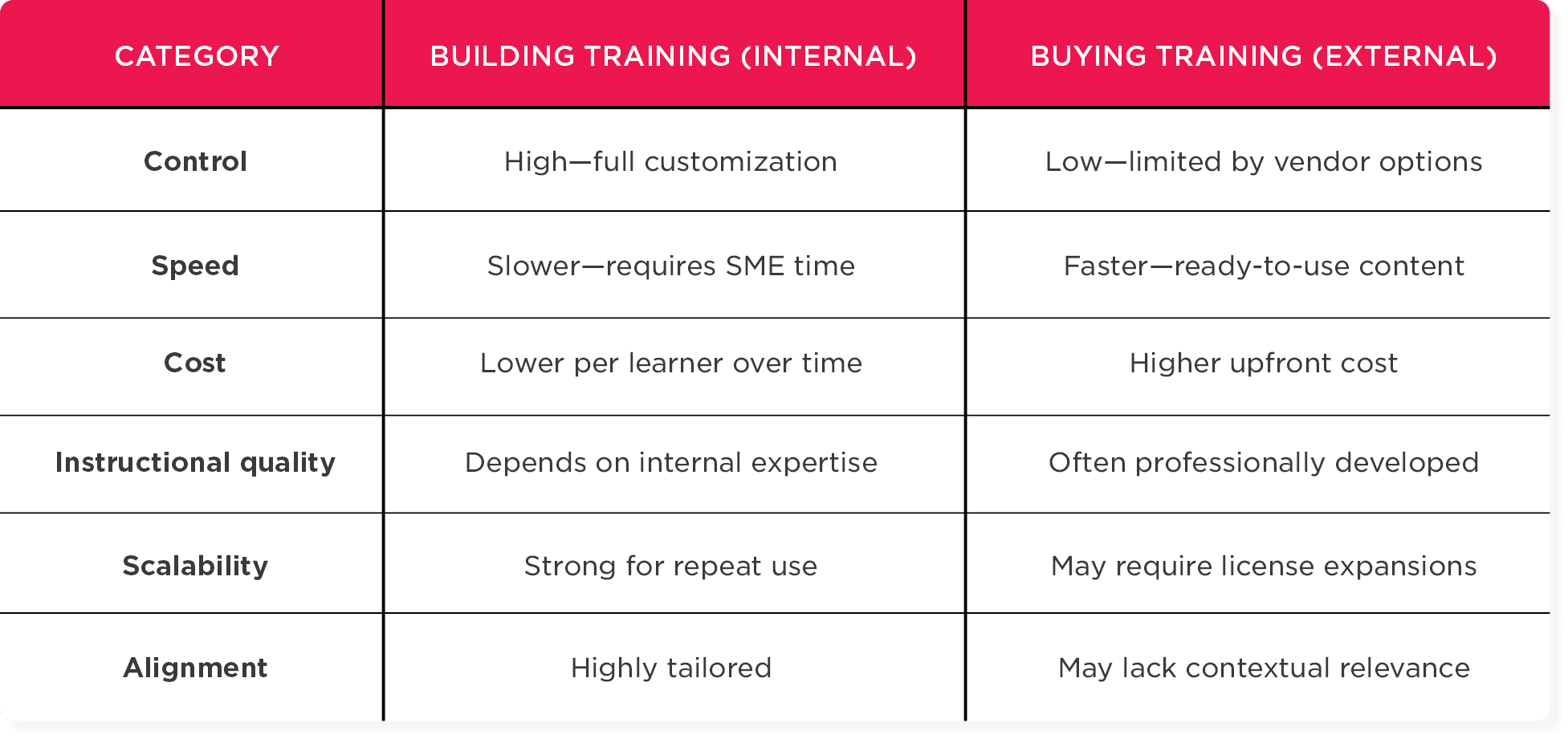
Activity: Fill out your own comparison table
Now it’s your turn. Use the sliders below to evaluate your needs across six key categories. For each category, put a dot (◉) where your training initiative falls on the spectrum—from fully internal (build) to fully external (buy). For example, under control, how much customization is needed for this program to be successful? Heavily customized content would lean towards an internal focus, while more generic training could be acquired externally. Look for patterns. Are your priorities clustering on one side?
Have a real think about what really matters to your organization—whether that’s speed, scale, alignment, or perhaps something else.
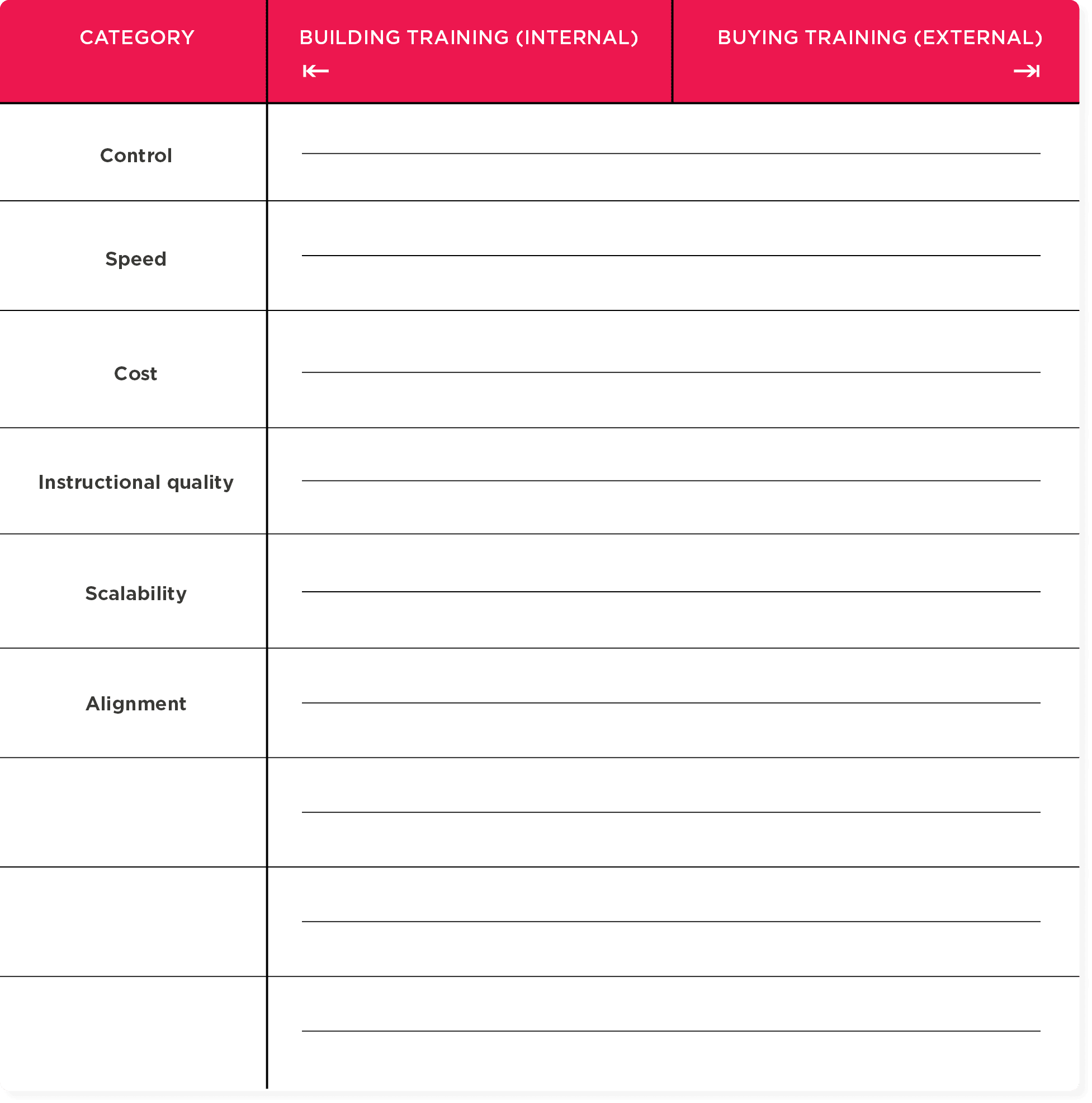
<<Download the workbook in document format to find the best delivery method for your L&D strategy.>>
Step 2: Analyze the knowledge to transfer
Training isn’t a one-size-fits-all process.
Some skills are entirely unique to your organization’s culture, tools, or processes, while others are standardized across industries and can easily be outsourced.
To make smart L&D decisions, it’s important to analyze the type of knowledge you’re trying to transfer.
- Explicit knowledge. This is more formal, structured, and easy to document. It works well with lectures, manuals, and classes.
- Tacit knowledge. This is learned through experience, like reading a room or handling a sensitive conversation. Teaching it takes time, mentoring, and real-world exposure.
- Implicit knowledge. This includes unspoken habits, mental models, or cultural norms. It requires consistent practice and feedback to be properly internalized.
Most work behaviors are a blend of all three. However, most of the time, organizations tend to default to training methods that only work for explicit knowledge. Why? Because they’re faster and easier to deliver.
That can leave big gaps when it comes to behavior, confidence, and performance.
Clarifying which types of knowledge are involved helps you shape your strategy, set realistic expectations, and understand the true time-to-proficiency. It also helps managers and SMEs know what part they play in getting people up to speed.
AI can help support this process, especially for surface-level or searchable content.
But when skills need to be applied in real-time, or when nuance and context matter, you just can’t beat experience and human support.
This step helps you to prioritize which training initiatives to build in-house, buy from external providers, or blend based on the complexity, urgency, and purpose of the content.
Example: Knowledge transfer table
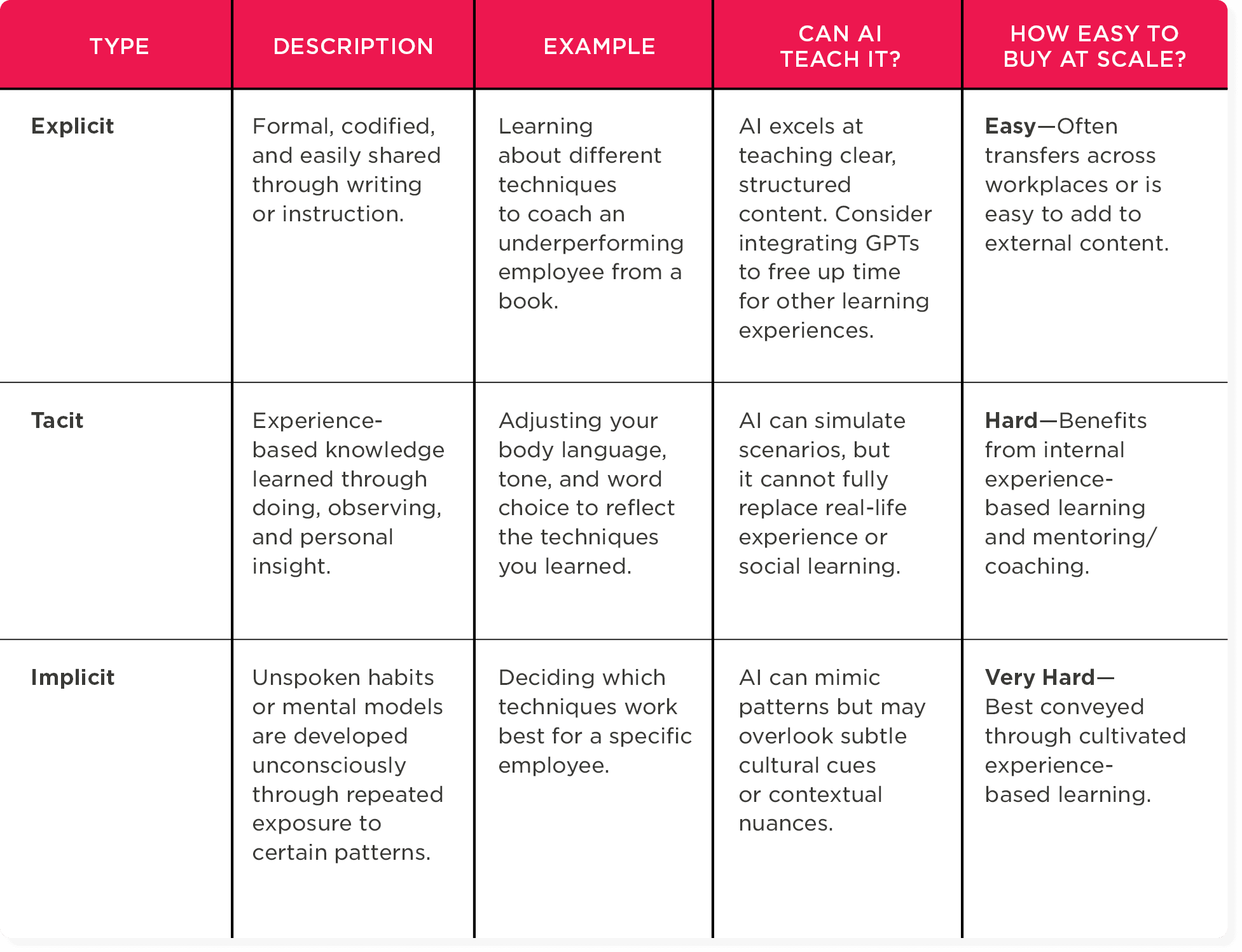
Recommended For Further Reading
Activity: Map your own knowledge transfer approach
Choose 2-3 training initiatives you’re currently working on or that you plan to launch soon.
For each one:
- Describe what you need to teach; you may need to break a single initiative into different content areas or use all three types of knowledge (plus sub-training) for complex teachings, such as a sales enablement process.
- Identify whether the knowledge is mostly explicit, tacit, or implicit
- Decide what kind of learning method makes the most sense
- Reflect on where (or whether) AI could support the learning process
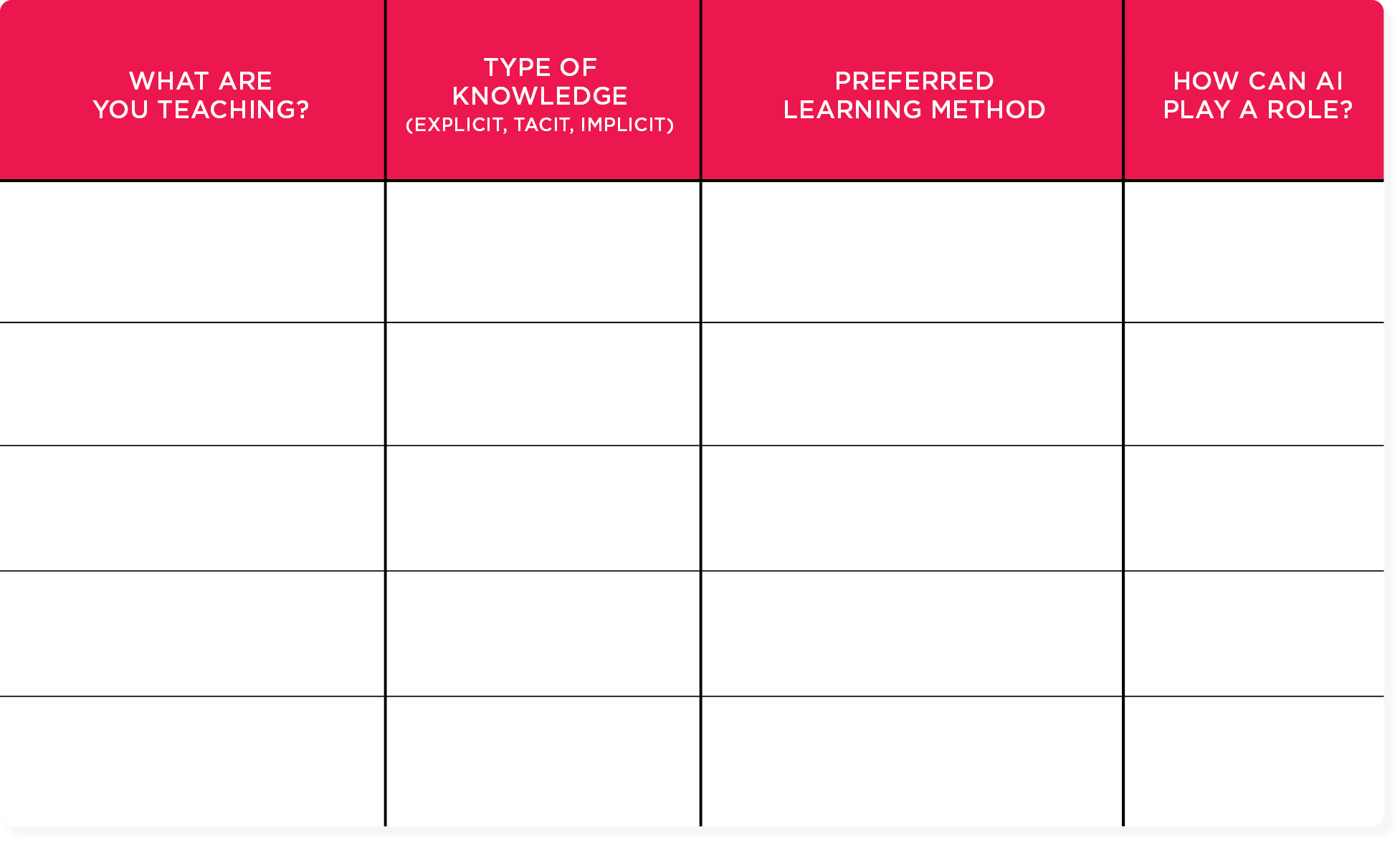
What you’re teaching works best when you shape how you teach it.
This exercise helps you think beyond generic instruction and design training that meets the challenge you’re facing.
<<Download the workbook in document format to find the right training for your company needs.>>
Step 3: Answer the 10 key decision questions
Even the best-looking, most organized plan can run into a few hiccups if your organization isn’t ready to execute.
That’s why this step is designed to help you pressure-test your plan before you fully commit.
These 10 questions highlight the realities of building training internally—from bandwidth and expertise to your budget and available tools. They also help flag early signs that you might be headed toward misalignment or overload.
The truth is that training initiatives can look great on paper but still fall a bit short of the mark in practice.
By spotting constraints up front, you can avoid any false starts and make sure your strategy is set up for success right from the start.
Activity: Assess your readiness
Do your best to answer each question honestly based on the specific training initiative you’re evaluating. There’s space to add any notes to clarify blockers or exceptions along the way.
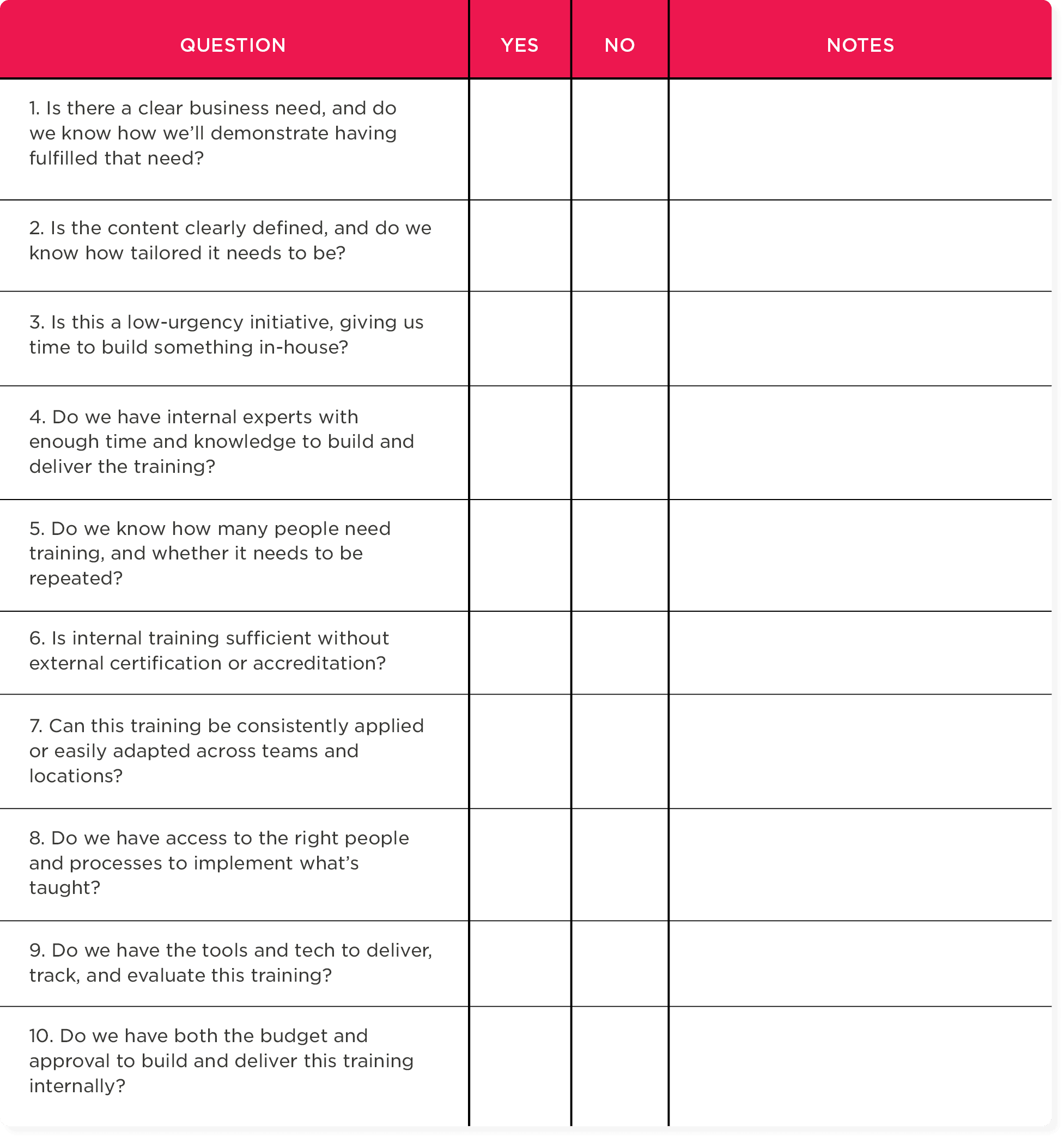
Remember that readiness is about more than just willingness. If you find that you’re answering “no” more often than “yes”, then external options—or a hybrid approach—may be the way forward for you and your organization.
Step 4: Apply a decision framework
So far, you’ve evaluated the tradeoffs, analyzed the knowledge to transfer, and pressure-tested your readiness.
Now, it’s time to bring everything together into a structured, justifiable decision.
Whether you’re presenting a recommendation to leadership or mapping out your next quarter, this framework gives you the clarity and rationale to act with confidence.
Having a documented recommendation is useful for decision-making, but it also helps to support alignment, set expectations, and secure buy-in from key stakeholders.
Example: Decision summary table
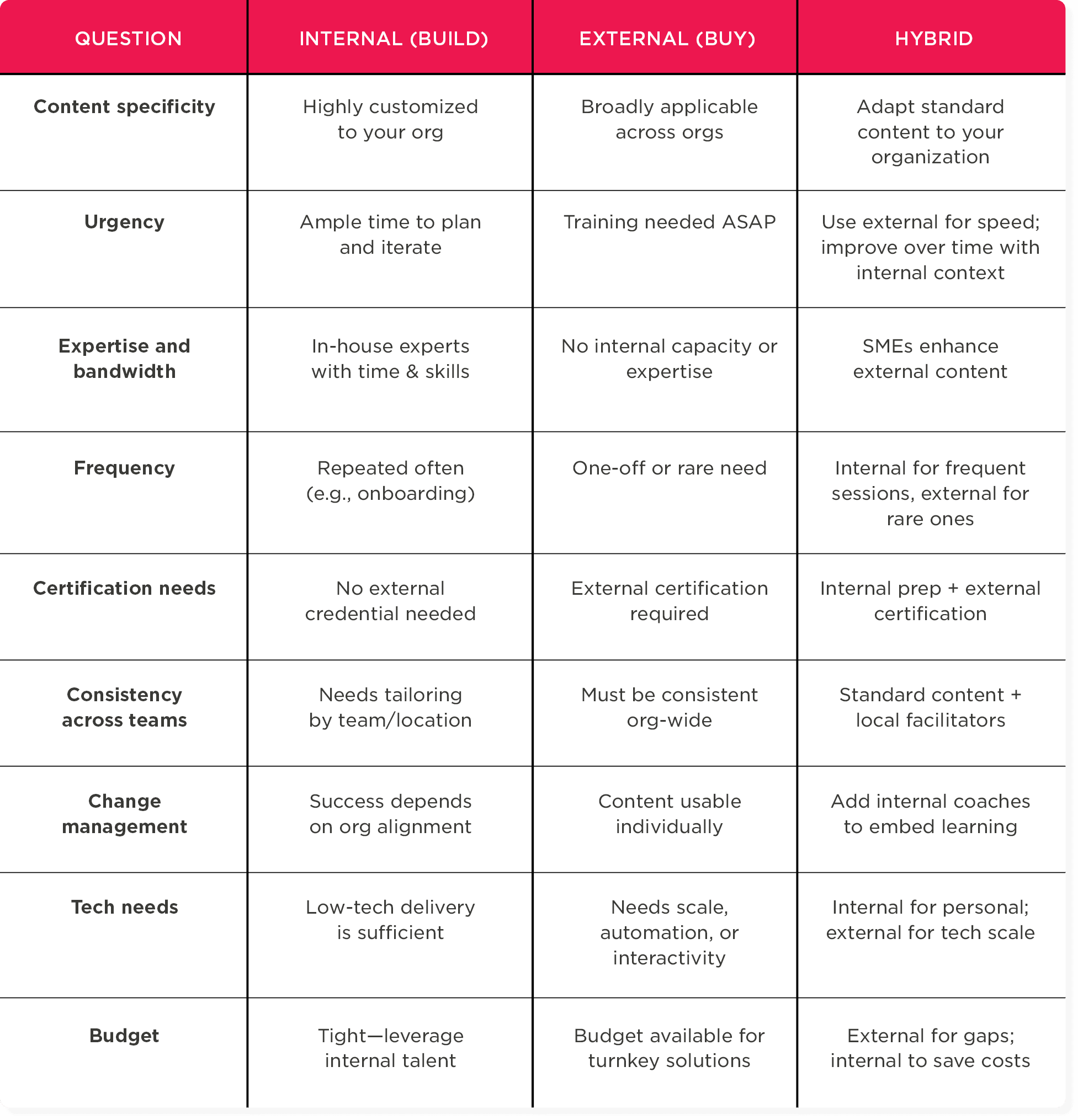
Activity: Complete your own decision summary
Use the table below to summarize the rationale for your recommendation.
Be honest about any risks or constraints you may have, and document the actions required to bring your strategy to life.
This is where you can turn analysis into action. With a clear decision and strong rationale, you can move forward with focus and bring your team along with you.
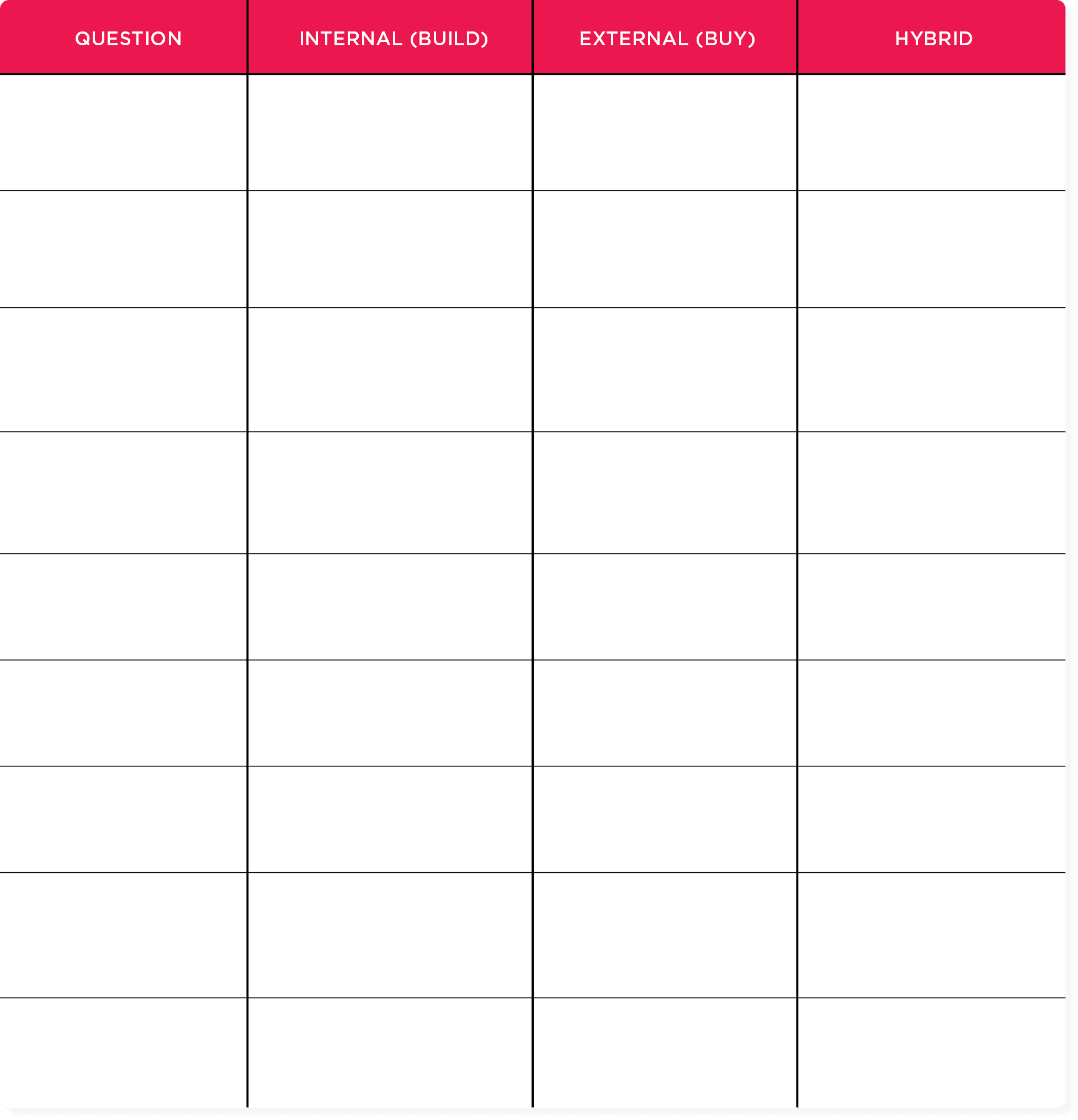
<<Download the workbook in document format to decide which L&D program suites you best.>>
Step 5: Define and measure the training impact
Even well-designed training can lose visibility if you don’t define how it contributes to your business success.
Measuring outcomes helps you in so many ways. You can prove value, optimize learning experiences, and even make the case for ongoing investment.
Because without metrics, training can slip into guesswork.
This step helps you link learning outcomes to business results and communicate that value clearly to leadership.
Example: Evaluating the impact
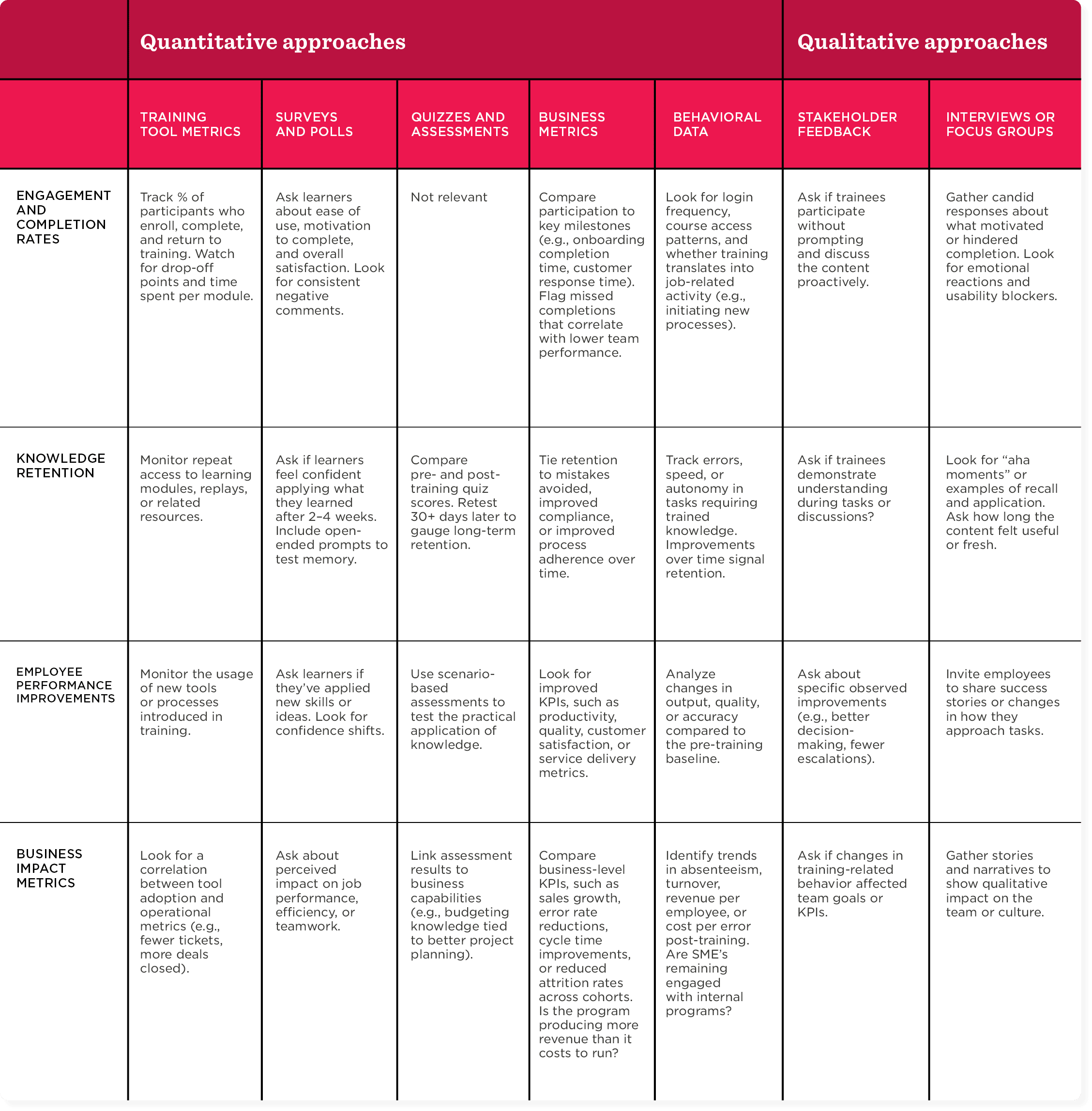
Activity: Create your training impact plan
Use the table below to define how you’ll evaluate your success.
Think about it across four levels:
- Engagement and completion rates. Did the people find the training engaging and relevant?
- Knowledge retention. Did they retain the knowledge or skills?
- Employee performance improvements. Did behavior or performance change?
- Business impact metrics. Did the training support your business metric (e.g., retention, productivity, customer satisfaction)?
Fill in your answers for a recent or planned training program. Make sure to be realistic about your baselines and choose KPIs that you can track over time.
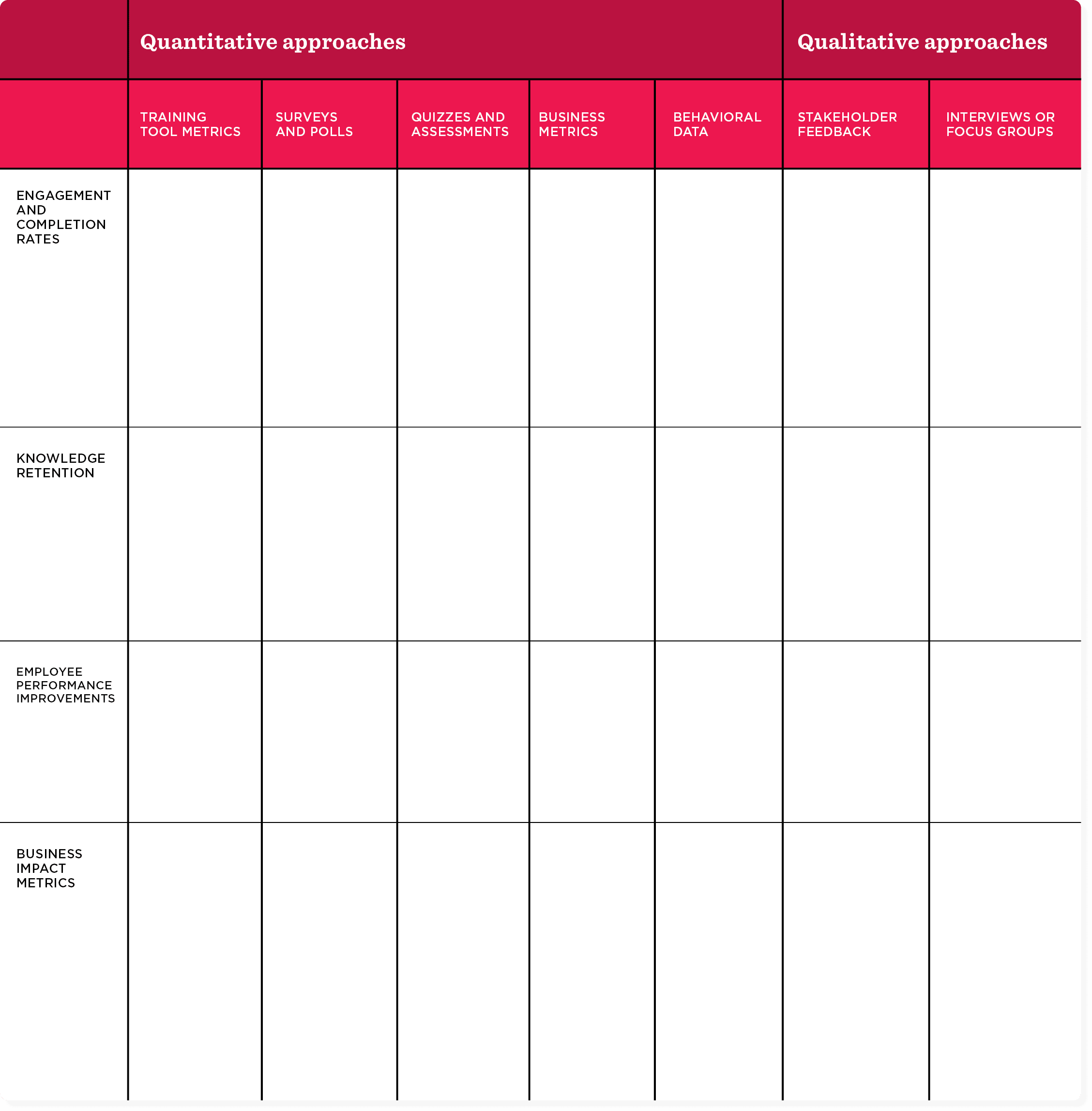
Remember that if you want training to be strategic, treat it like any other business investment—track, measure, and share the results.
Step 6: Evaluate the long-term fit of your training strategy
Training is never a one-and-done initiative.
Every training program benefits from regular reflection and a hearty refresh, especially with evolving goals, teams, and tools.
Revisiting your approach helps you to make sure it stays relevant and high-impact. As we said, business goals shift, people change, and technology is constantly evolving—so your L&D approach needs to keep up.
A program that started strong may eventually need rethinking to stay relevant, efficient, and impactful as business needs evolve. This step helps you assess whether your current strategy still delivers value and where you might need to refresh, reallocate, or rethink.
Activity: Evaluation checklist
Use the table below to help you assess your existing or recently completed training initiative.
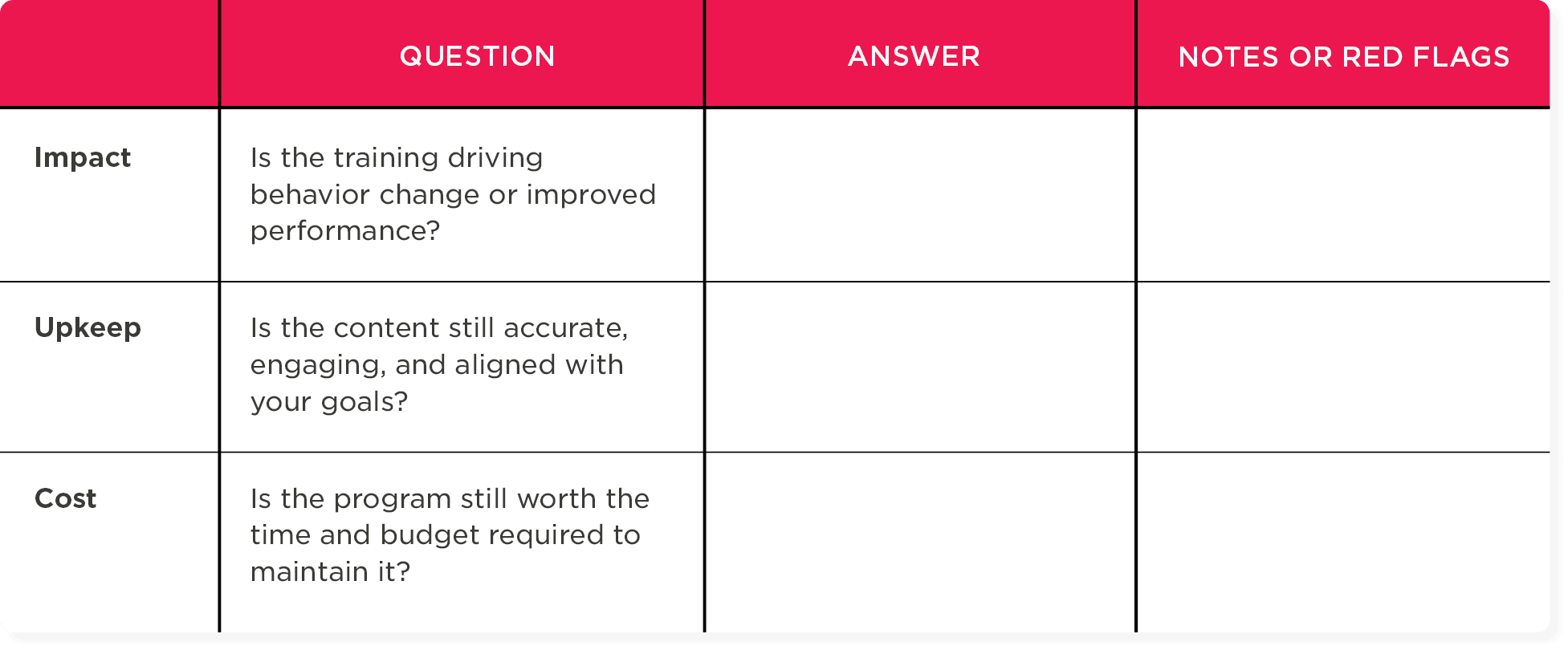
Based on your answers above, it’s now time to decide what action to take.
This is your opportunity to align your training strategy with what’s actually working—and what needs to change.
Choose the option that best fits your current context:
- Keep as is. No major changes are needed. The program is relevant, effective, and efficient.
- Refresh the content. There are a few elements that need updates, but the format and purpose still fit.
- Switch delivery model. Consider moving from internal to external delivery (or vice versa) or blending both.
- Sunset or replace. The training is no longer serving its purpose and should be phased out in favor of a better fit.
Great training doesn’t stand still. It’s always changing, adapting to the circumstances around it.
Regular reviews help make sure your L&D programs always stay fully aligned with your business needs—and also help you make sure you’re always delivering a good ROI.
Summary and next steps
By making your way through this workbook, you’ve:
- Weighed the tradeoffs of building vs. buying training
- Mapped knowledge needs and readiness factors
- Answered our 10 critical questions to guide your decision
- Applied a structured framework to recommend a path
- Defined how to measure success and how to grow over time
Next steps:
- Share your completed workbook with your key stakeholders
- Present your recommendation using the summary table
- Set a review cadence (quarterly, biannually, or annually) to keep your L&D strategy fresh and on track
The importance of training can never be overstated. It’s a capability that drives workforce development, talent retention, and long-term performance.
And with the help of this workbook, you can make sure that every decision you make counts.
<<Download the workbook in document format to decide which L&D program suites you best.>>
